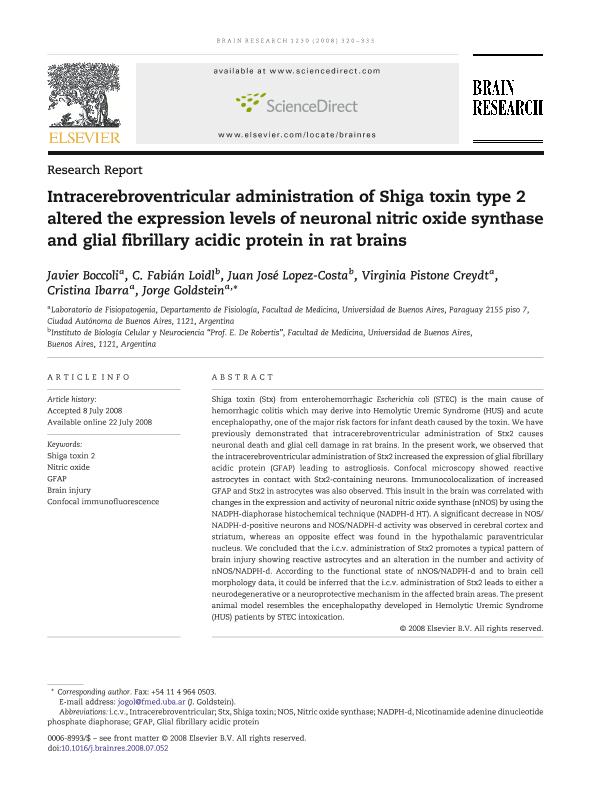Artículo
Intracerebroventricular administration of Shiga toxin type 2 altered the expression levels of neuronal nitric oxide synthase and glial fibrillary acidic protein in rat brains
Boccoli, Javier; Loidl, Cesar Fabian ; López, Juan José
; López, Juan José ; Pistone Creydt, Virginia
; Pistone Creydt, Virginia ; Ibarra, Cristina Adriana
; Ibarra, Cristina Adriana ; Goldstein Raij, Jorge
; Goldstein Raij, Jorge
 ; López, Juan José
; López, Juan José ; Pistone Creydt, Virginia
; Pistone Creydt, Virginia ; Ibarra, Cristina Adriana
; Ibarra, Cristina Adriana ; Goldstein Raij, Jorge
; Goldstein Raij, Jorge
Fecha de publicación:
2008
Editorial:
Elsevier Science
Revista:
Brain Research
ISSN:
0006-8993
e-ISSN:
1872-6240
Idioma:
Inglés
Tipo de recurso:
Artículo publicado
Clasificación temática:
Resumen
Shiga toxin (Stx) from enterohemorrhagic Escherichia coli (STEC) is the main cause of hemorrhagic colitis which may derive into Hemolytic Uremic Syndrome (HUS) and acute encephalopathy, one of the major risk factors for infant death caused by the toxin. We have previously demonstrated that intracerebroventricular administration of Stx2 causes neuronal death and glial cell damage in rat brains. In the present work, we observed that the intracerebroventricular administration of Stx2 increased the expression of glial fibrillary acidic protein (GFAP) leading to astrogliosis. Confocal microscopy showed reactive astrocytes in contact with Stx2-containing neurons. Immunocolocalization of increased GFAP and Stx2 in astrocytes was also observed. This insult in the brain was correlated with changes in the expression and activity of neuronal nitric oxide synthase (nNOS) by using the NADPH-diaphorase histochemical technique (NADPH-d HT). A significant decrease in NOS/NADPH-d-positive neurons and NOS/NADPH-d activity was observed in cerebral cortex and striatum, whereas an opposite effect was found in the hypothalamic paraventricular nucleus. We concluded that the i.c.v. administration of Stx2 promotes a typical pattern of brain injury showing reactive astrocytes and an alteration in the number and activity of nNOS/NADPH-d. According to the functional state of nNOS/NADPH-d and to brain cell morphology data, it could be inferred that the i.c.v. administration of Stx2 leads to either a neurodegenerative or a neuroprotective mechanism in the affected brain areas. The present animal model resembles the encephalopathy developed in Hemolytic Uremic Syndrome (HUS) patients by STEC intoxication.
Palabras clave:
Shiga Toxin 2
,
Nitric Oxide
,
Gfap
,
Brain Injury
Archivos asociados
Licencia
Identificadores
Colecciones
Articulos(IBCN)
Articulos de INST.DE BIOLO.CEL.Y NEURCS."PROF.E.DE ROBERTIS"
Articulos de INST.DE BIOLO.CEL.Y NEURCS."PROF.E.DE ROBERTIS"
Articulos(IBYME)
Articulos de INST.DE BIOLOGIA Y MEDICINA EXPERIMENTAL (I)
Articulos de INST.DE BIOLOGIA Y MEDICINA EXPERIMENTAL (I)
Citación
Boccoli, Javier; Loidl, Cesar Fabian; López, Juan José; Pistone Creydt, Virginia; Ibarra, Cristina Adriana; et al.; Intracerebroventricular administration of Shiga toxin type 2 altered the expression levels of neuronal nitric oxide synthase and glial fibrillary acidic protein in rat brains; Elsevier Science; Brain Research; 1230; -1-2008; 320-333
Compartir
Altmétricas



